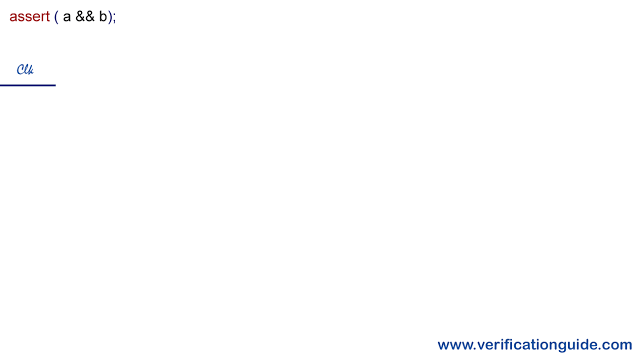SystemVerilog Assertions
Table of Contents
Assertions are primarily used to validate the behavior of a design. An assertion is a check embedded in design or bound to a design unit during the simulation. Warnings or errors are generated on the failure of a specific condition or sequence of events.
Assertions are used to,
- Check the occurrence of a specific condition or sequence of events.
- Provide functional coverage.
There are two kinds of assertions:
- Immediate Assertions
- Concurrent Assertions
Immediate Assertions:
Immediate assertions check for a condition at the current simulation time.
An immediate assertion is the same as an if..else statement with assertion control. Immediate assertions have to be placed in a procedural block definition.
Syntax
label: assert(expression) action_block;
- The optional statement label (identifier and colon) creates a named block around the assertion statement
- The action block is executed immediately after the evaluation of the assert expression
- The action_block specifies what actions are taken upon success or failure of the assertion
action_block;
pass_statement; else fail_statement;
- The pass statement is executed if the expression evaluates to true
- The statement associated with else is called a fail statement and is executed if the expression evaluates to false
- Both pass and fail statements are optional
- Since the assertion is a statement that something must be true, the failure of an assertion shall have a severity associated with it. By default, the severity of an assertion failure is an error.
- Other severity levels can be specified by including one of the following severity system tasks in the fail statement:
- $fatal is a run-time fatal.
- $error is a run-time error.
- $warning is a run-time warning, which can be suppressed in a tool-specific manner.
- $info indicates that the assertion failure carries no specific severity.
- If an assertion fails and no else clause is specified, the tool shall, by default call $error.
Below are the different forms of immediate assertion syntax with and without optional items
//With Pass and Fail statement; Fail verbosity info;
assert(expression) $display(“expression evaluates to true”); else $display(“expression evaluates to false”);
//Only With Pass statement;
assert(expression) $display(“expression evaluates to true”);
//With Pass and Fail statement; Fail verbosity fatal;
assert(expression) $display(“expression evaluates to true”); else $fatal(“expression evaluates to false”);
//Only With Fail statement; Multiple statements in Faile condition and Fail verbosity fatal;
assert(expression)
else begin
…….
…….
$fatal(“expression evaluates to false”);
end
//Only With Fail statement; Fail verbosity warning;
assert(expression) else $warning(“expression evaluates to false”);
//With Label and Fail statement; Fail verbosity warning;
label: assert(expression) else $warning(“expression evaluates to false”);
Immediate assertion example
Below is the simple immediate assertion,
always @(posedge clk) assert (a && b);
Below is the wave diagram for the above assertion.
Condition (a && b) will be checked at every posedge of the clock, failure in the condition leads to an assertion failure.

module asertion_ex;
bit clk,a,b;
//clock generation
always #5 clk = ~clk;
//generating 'a'
initial begin
a=1;
b=1;
#15 b=0;
#10 b=1;
a=0;
#20 a=1;
#10;
$finish;
end
//Immediate assertion
always @(posedge clk) assert (a && b);
endmodule
Simulator Output

ncsim: *E,ASRTST (./testbench.sv,23): (time 15 NS) Assertion asertion_ex.__assert_1 has failed ncsim: *E,ASRTST (./testbench.sv,23): (time 25 NS) Assertion asertion_ex.__assert_1 has failed ncsim: *E,ASRTST (./testbench.sv,23): (time 35 NS) Assertion asertion_ex.__assert_1 has failed Simulation complete via $finish(1) at time 55 NS + 0
Concurrent Assertions:
Concurrent assertions check the sequence of events spread over multiple clock cycles.
- The concurrent assertion is evaluated only at the occurrence of a clock tick
- The test expression is evaluated at clock edges based on the sampled values of the variables involved
- It can be placed in a procedural block, a module, an interface or a program definition
c_assert: assert property(@(posedge clk) not(a && b));
The Keyword differentiates the immediate assertion from the concurrent assertion is “property.”
